Xiang Song
Dynamic Mixture-of-Experts for Incremental Graph Learning
Aug 13, 2025Abstract:Graph incremental learning is a learning paradigm that aims to adapt trained models to continuously incremented graphs and data over time without the need for retraining on the full dataset. However, regular graph machine learning methods suffer from catastrophic forgetting when applied to incremental learning settings, where previously learned knowledge is overridden by new knowledge. Previous approaches have tried to address this by treating the previously trained model as an inseparable unit and using techniques to maintain old behaviors while learning new knowledge. These approaches, however, do not account for the fact that previously acquired knowledge at different timestamps contributes differently to learning new tasks. Some prior patterns can be transferred to help learn new data, while others may deviate from the new data distribution and be detrimental. To address this, we propose a dynamic mixture-of-experts (DyMoE) approach for incremental learning. Specifically, a DyMoE GNN layer adds new expert networks specialized in modeling the incoming data blocks. We design a customized regularization loss that utilizes data sequence information so existing experts can maintain their ability to solve old tasks while helping the new expert learn the new data effectively. As the number of data blocks grows over time, the computational cost of the full mixture-of-experts (MoE) model increases. To address this, we introduce a sparse MoE approach, where only the top-$k$ most relevant experts make predictions, significantly reducing the computation time. Our model achieved 4.92\% relative accuracy increase compared to the best baselines on class incremental learning, showing the model's exceptional power.
Boosting Domain Incremental Learning: Selecting the Optimal Parameters is All You Need
May 29, 2025Abstract:Deep neural networks (DNNs) often underperform in real-world, dynamic settings where data distributions change over time. Domain Incremental Learning (DIL) offers a solution by enabling continual model adaptation, with Parameter-Isolation DIL (PIDIL) emerging as a promising paradigm to reduce knowledge conflicts. However, existing PIDIL methods struggle with parameter selection accuracy, especially as the number of domains and corresponding classes grows. To address this, we propose SOYO, a lightweight framework that improves domain selection in PIDIL. SOYO introduces a Gaussian Mixture Compressor (GMC) and Domain Feature Resampler (DFR) to store and balance prior domain data efficiently, while a Multi-level Domain Feature Fusion Network (MDFN) enhances domain feature extraction. Our framework supports multiple Parameter-Efficient Fine-Tuning (PEFT) methods and is validated across tasks such as image classification, object detection, and speech enhancement. Experimental results on six benchmarks demonstrate SOYO's consistent superiority over existing baselines, showcasing its robustness and adaptability in complex, evolving environments. The codes will be released in https://github.com/qwangcv/SOYO.
Deal: Distributed End-to-End GNN Inference for All Nodes
Mar 04, 2025
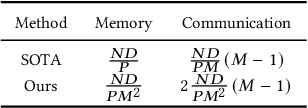
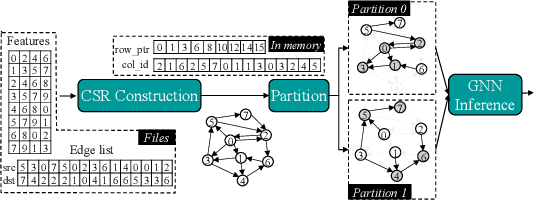
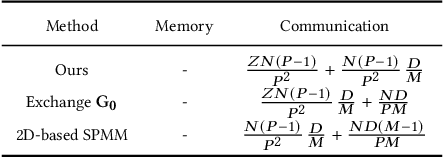
Abstract:Graph Neural Networks (GNNs) are a new research frontier with various applications and successes. The end-to-end inference for all nodes, is common for GNN embedding models, which are widely adopted in applications like recommendation and advertising. While sharing opportunities arise in GNN tasks (i.e., inference for a few nodes and training), the potential for sharing in full graph end-to-end inference is largely underutilized because traditional efforts fail to fully extract sharing benefits due to overwhelming overheads or excessive memory usage. This paper introduces Deal, a distributed GNN inference system that is dedicated to end-to-end inference for all nodes for graphs with multi-billion edges. First, we unveil and exploit an untapped sharing opportunity during sampling, and maximize the benefits from sharing during subsequent GNN computation. Second, we introduce memory-saving and communication-efficient distributed primitives for lightweight 1-D graph and feature tensor collaborative partitioning-based distributed inference. Third, we introduce partitioned, pipelined communication and fusing feature preparation with the first GNN primitive for end-to-end inference. With Deal, the end-to-end inference time on real-world benchmark datasets is reduced up to 7.70 x and the graph construction time is reduced up to 21.05 x, compared to the state-of-the-art.
Space Rotation with Basis Transformation for Training-free Test-Time Adaptation
Feb 27, 2025Abstract:With the development of visual-language models (VLM) in downstream task applications, test-time adaptation methods based on VLM have attracted increasing attention for their ability to address changes distribution in test-time. Although prior approaches have achieved some progress, they typically either demand substantial computational resources or are constrained by the limitations of the original feature space, rendering them less effective for test-time adaptation tasks. To address these challenges, we propose a training-free feature space rotation with basis transformation for test-time adaptation. By leveraging the inherent distinctions among classes, we reconstruct the original feature space and map it to a new representation, thereby enhancing the clarity of class differences and providing more effective guidance for the model during testing. Additionally, to better capture relevant information from various classes, we maintain a dynamic queue to store representative samples. Experimental results across multiple benchmarks demonstrate that our method outperforms state-of-the-art techniques in terms of both performance and efficiency.
Prompt-Agnostic Adversarial Perturbation for Customized Diffusion Models
Aug 20, 2024



Abstract:Diffusion models have revolutionized customized text-to-image generation, allowing for efficient synthesis of photos from personal data with textual descriptions. However, these advancements bring forth risks including privacy breaches and unauthorized replication of artworks. Previous researches primarily center around using prompt-specific methods to generate adversarial examples to protect personal images, yet the effectiveness of existing methods is hindered by constrained adaptability to different prompts. In this paper, we introduce a Prompt-Agnostic Adversarial Perturbation (PAP) method for customized diffusion models. PAP first models the prompt distribution using a Laplace Approximation, and then produces prompt-agnostic perturbations by maximizing a disturbance expectation based on the modeled distribution. This approach effectively tackles the prompt-agnostic attacks, leading to improved defense stability. Extensive experiments in face privacy and artistic style protection, demonstrate the superior generalization of our method in comparison to existing techniques.
GraphStorm: all-in-one graph machine learning framework for industry applications
Jun 10, 2024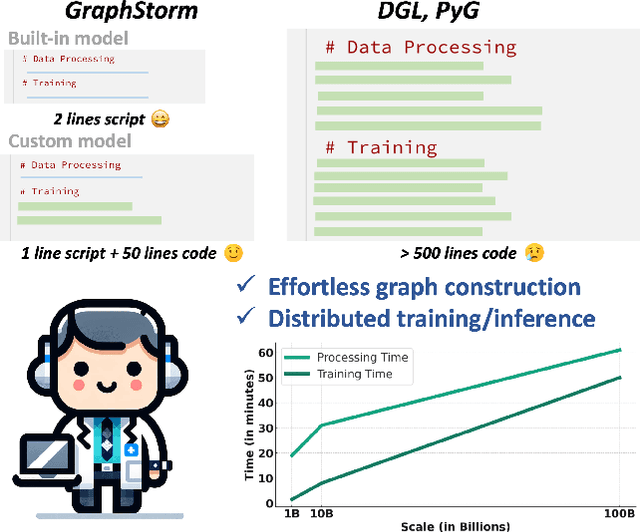

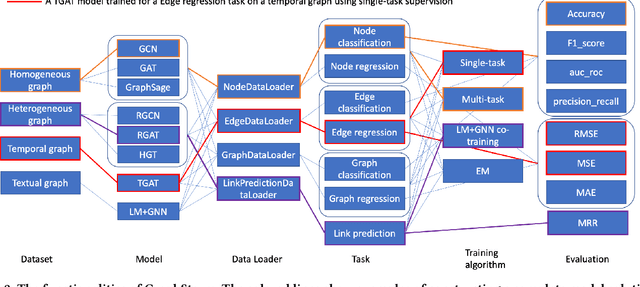

Abstract:Graph machine learning (GML) is effective in many business applications. However, making GML easy to use and applicable to industry applications with massive datasets remain challenging. We developed GraphStorm, which provides an end-to-end solution for scalable graph construction, graph model training and inference. GraphStorm has the following desirable properties: (a) Easy to use: it can perform graph construction and model training and inference with just a single command; (b) Expert-friendly: GraphStorm contains many advanced GML modeling techniques to handle complex graph data and improve model performance; (c) Scalable: every component in GraphStorm can operate on graphs with billions of nodes and can scale model training and inference to different hardware without changing any code. GraphStorm has been used and deployed for over a dozen billion-scale industry applications after its release in May 2023. It is open-sourced in Github: https://github.com/awslabs/graphstorm.
Parameter-Efficient Tuning Large Language Models for Graph Representation Learning
Apr 28, 2024
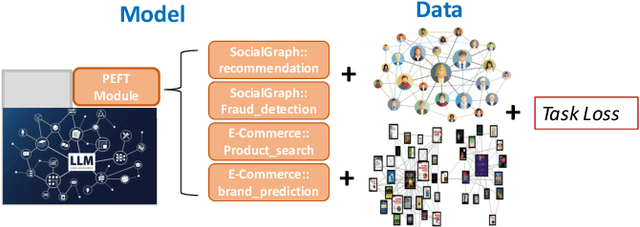

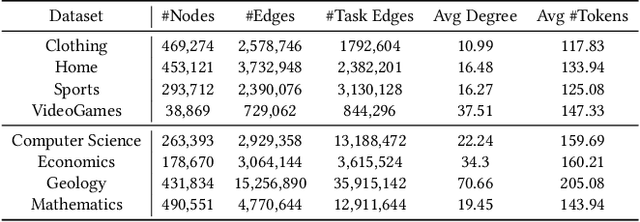
Abstract:Text-rich graphs, which exhibit rich textual information on nodes and edges, are prevalent across a wide range of real-world business applications. Large Language Models (LLMs) have demonstrated remarkable abilities in understanding text, which also introduced the potential for more expressive modeling in text-rich graphs. Despite these capabilities, efficiently applying LLMs to representation learning on graphs presents significant challenges. Recently, parameter-efficient fine-tuning methods for LLMs have enabled efficient new task generalization with minimal time and memory consumption. Inspired by this, we introduce Graph-aware Parameter-Efficient Fine-Tuning - GPEFT, a novel approach for efficient graph representation learning with LLMs on text-rich graphs. Specifically, we utilize a graph neural network (GNN) to encode structural information from neighboring nodes into a graph prompt. This prompt is then inserted at the beginning of the text sequence. To improve the quality of graph prompts, we pre-trained the GNN to assist the frozen LLM in predicting the next token in the node text. Compared with existing joint GNN and LMs, our method directly generate the node embeddings from large language models with an affordable fine-tuning cost. We validate our approach through comprehensive experiments conducted on 8 different text-rich graphs, observing an average improvement of 2% in hit@1 and Mean Reciprocal Rank (MRR) in link prediction evaluations. Our results demonstrate the efficacy and efficiency of our model, showing that it can be smoothly integrated with various large language models, including OPT, LLaMA and Falcon.
NetInfoF Framework: Measuring and Exploiting Network Usable Information
Feb 12, 2024



Abstract:Given a node-attributed graph, and a graph task (link prediction or node classification), can we tell if a graph neural network (GNN) will perform well? More specifically, do the graph structure and the node features carry enough usable information for the task? Our goals are (1) to develop a fast tool to measure how much information is in the graph structure and in the node features, and (2) to exploit the information to solve the task, if there is enough. We propose NetInfoF, a framework including NetInfoF_Probe and NetInfoF_Act, for the measurement and the exploitation of network usable information (NUI), respectively. Given a graph data, NetInfoF_Probe measures NUI without any model training, and NetInfoF_Act solves link prediction and node classification, while two modules share the same backbone. In summary, NetInfoF has following notable advantages: (a) General, handling both link prediction and node classification; (b) Principled, with theoretical guarantee and closed-form solution; (c) Effective, thanks to the proposed adjustment to node similarity; (d) Scalable, scaling linearly with the input size. In our carefully designed synthetic datasets, NetInfoF correctly identifies the ground truth of NUI and is the only method being robust to all graph scenarios. Applied on real-world datasets, NetInfoF wins in 11 out of 12 times on link prediction compared to general GNN baselines.
On the Initialization of Graph Neural Networks
Dec 05, 2023



Abstract:Graph Neural Networks (GNNs) have displayed considerable promise in graph representation learning across various applications. The core learning process requires the initialization of model weight matrices within each GNN layer, which is typically accomplished via classic initialization methods such as Xavier initialization. However, these methods were originally motivated to stabilize the variance of hidden embeddings and gradients across layers of Feedforward Neural Networks (FNNs) and Convolutional Neural Networks (CNNs) to avoid vanishing gradients and maintain steady information flow. In contrast, within the GNN context classical initializations disregard the impact of the input graph structure and message passing on variance. In this paper, we analyze the variance of forward and backward propagation across GNN layers and show that the variance instability of GNN initializations comes from the combined effect of the activation function, hidden dimension, graph structure and message passing. To better account for these influence factors, we propose a new initialization method for Variance Instability Reduction within GNN Optimization (Virgo), which naturally tends to equate forward and backward variances across successive layers. We conduct comprehensive experiments on 15 datasets to show that Virgo can lead to superior model performance and more stable variance at initialization on node classification, link prediction and graph classification tasks. Codes are in https://github.com/LspongebobJH/virgo_icml2023.
TouchUp-G: Improving Feature Representation through Graph-Centric Finetuning
Sep 25, 2023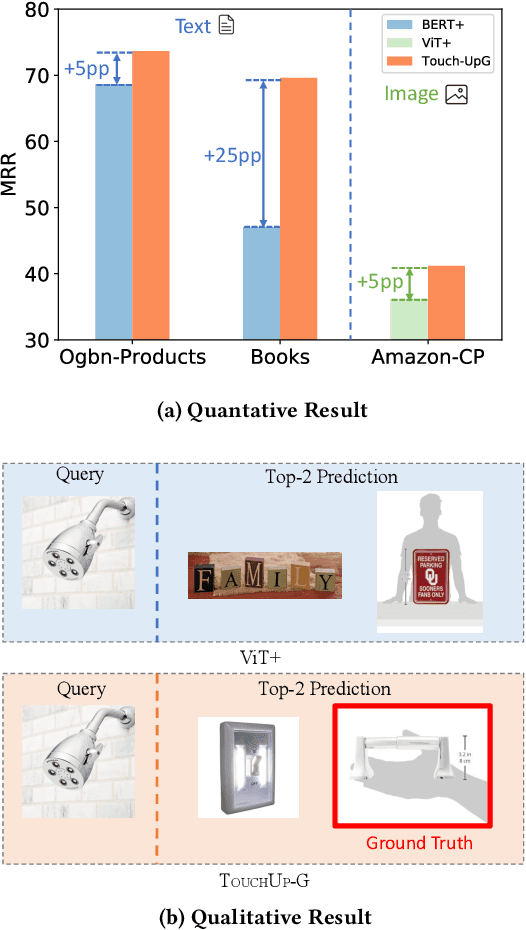
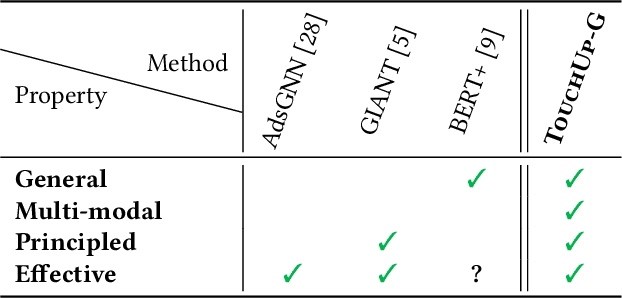
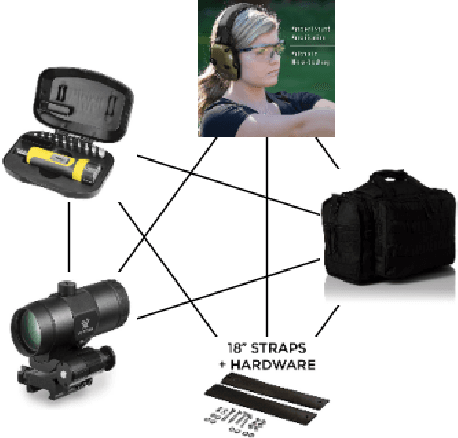
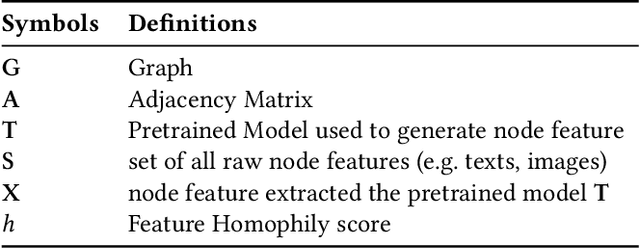
Abstract:How can we enhance the node features acquired from Pretrained Models (PMs) to better suit downstream graph learning tasks? Graph Neural Networks (GNNs) have become the state-of-the-art approach for many high-impact, real-world graph applications. For feature-rich graphs, a prevalent practice involves utilizing a PM directly to generate features, without incorporating any domain adaptation techniques. Nevertheless, this practice is suboptimal because the node features extracted from PM are graph-agnostic and prevent GNNs from fully utilizing the potential correlations between the graph structure and node features, leading to a decline in GNNs performance. In this work, we seek to improve the node features obtained from a PM for downstream graph tasks and introduce TOUCHUP-G, which has several advantages. It is (a) General: applicable to any downstream graph task, including link prediction which is often employed in recommender systems; (b) Multi-modal: able to improve raw features of any modality (e.g. images, texts, audio); (c) Principled: it is closely related to a novel metric, feature homophily, which we propose to quantify the potential correlations between the graph structure and node features and we show that TOUCHUP-G can effectively shrink the discrepancy between the graph structure and node features; (d) Effective: achieving state-of-the-art results on four real-world datasets spanning different tasks and modalities.
 Add to Chrome
Add to Chrome Add to Firefox
Add to Firefox Add to Edge
Add to Edge